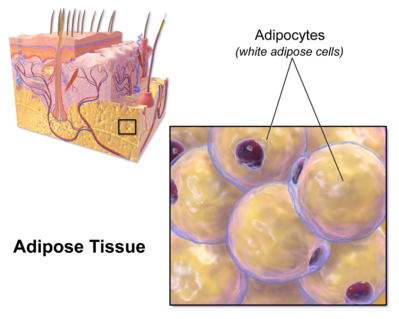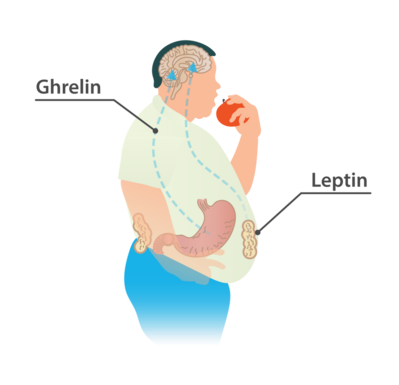Adipose Tissue
Original Editor - lucinda hampton
Top Contributors - Lucinda hampton, Kim Jackson, Vidya Acharya and Sai Kripa
Introduction[edit | edit source]
The more technical term for body fat is adipose tissue. It is a loose connective tissue composed of fat cells, with individual cells being called adipocytes. [1]
Image 1: Adipose tissue
Adipocytes contain lipid droplets of stored triglycerides. These cells swell as they store fat and shrink when the fat is used for energy.
Adipose tissue helps to store energy in the form of fat, cushion internal organs, and insulate the body.
There are three types of adipose tissue: white, brown, and beige adipose.
- White adipose stores energy and helps to insulate the body.
- Brown and beige adipose tissue burn energy and generate heat. Their colour is derived from the abundance of blood vessels and mitochondria in the tissue.
Adipose tissue also produces hormones, such as adiponectin, which help to burn fat and reduce body weight.[2]
Location[edit | edit source]
Adipose tissue can be found in a number of different places throughout the body.
Image 2: White adipose falls under two major classifications: visceral, and subcutaneous, under the skin.
White adipose tissue is the most abundant type of fat in humans. It is distributed within subcutaneous fat, visceral fat, and bone marrow fat.
- Subcutaneous fat is found throughout the whole body, in the spaces between the skin and underlying muscles.
- Visceral fat is predominantly found around the organs in the abdominal cavity, such as the liver, intestines and kidneys, as well as in the peritoneum.
- White adipose tissue is also present in the bone marrow and can be found in the pericardium surrounding the heart, or cushioning other parts of the body, like the soles of the feet, eyeballs, and certain blood vessels.
Brown adipose tissue is mostly present during fetal life and in infants. With age, the amount of brown fat decreases progressively. In adults, remaining brown fat deposits can be found surrounding the vertebrae, above the clavicles, in the upper back, and in the mediastinum.
Normal Adipose Amounts[edit | edit source]
In healthy adults, adipose tissue usually comprises 20–25% of the total body weight. See Body Composition
- Specific body fat percentage varies considerably amongst individuals, ranging from less than 10% to over 40% of the total body weight.
- Increased levels of adipose tissue has been associated with several health problems, including obesity, diabetes mellitus, and heart disease, among others[3].
Main Function[edit | edit source]
The main function of:
- White adipocytes is to store excess energy in the form of fatty molecules, mainly triglycerides. Fat storage is regulated by several hormones, including insulin, glucagon, catecholamines (adrenaline and noradrenaline), and cortisol. Depending on the body’s immediate energy requirements, these hormones can either stimulate adipose tissue formation and storage (i.e. lipogenesis) or initiate the release of fat from adipose tissue (i.e. lipolysis). Under the influence of insulin, for instance, adipocytes can increase the uptake of blood glucose and transform it into fatty molecules, thereby increasing fat storage. White adipose tissue also helps cushion and protect parts of the body, as well as insulate the body from extreme temperatures.
- Brown fat is to use energy to generate heat through a process called non-shivering thermogenesis, which serves as an important defense mechanism to protect newborns against hypothermia. In adults, non-shivering thermogenesis becomes secondary to shivering thermogenesis, which is achieved by the contraction of skeletal muscles.[3]
Endocrine Function[edit | edit source]
Adipose tissue acts as an endocrine system organ by generating hormones that influence metabolic activity in other organ systems. Some of the hormones produced by adipose cells influence sex hormone metabolism, blood pressure regulation, insulin sensitivity, fat storage and use, blood clotting, and cell signaling. Adipose tissue performs these vital roles by secreting several biologically-active factors known as adipokines. These molecules contribute to a variety of different functions, including regulation of energy balance, food intake and satiety, inflammatory response, and metabolism of steroid hormones.
- A major function of adipose cells is to increase the body's sensitivity to insulin, thereby protecting against obesity.
- Adipocytes are also responsible for the production of the hormone leptin. Leptin is important in regulation of appetite and acts as a satiety factor.[2]
Image 3: Leptin (produced by adipocyctes) and Ghrelin - hunger hormones.
Interesting Facts[edit | edit source]
Fat, incorrect amounts, increases risk of Diabetes: Obesity can predispose a person to type 2 diabetes as can too little fat. Type 2 diabetes is a group of diseases in which the body has an impaired ability to produce or respond to the hormone insulin. And it turns out having too little fat is due in part to a lack of a lipid-storing “compartments,” which leads to an imbalance of triglyceride and free fatty acid levels, leading to insulin resistance.
6. YOUR LEVEL OF BODY FAT MAY BE INFLUENCED BY YOUR MICROBIOME.
Researchers at McMaster University have begun studying a new realm of therapies known as postbiotics, the by-products that bacteria leave behind, which help the body synthesize insulin more effectively. In a new study, scientists discovered that administering postbiotics to mice with obesity reduced their insulin sensitivity—without any need for weight loss—heralding promising potential treatments for obesity with type 2 diabetes.
Excess Fat promotes cancer: Adipose tissue also secrets “hormones that make cancer cells grow quicker,” says Mukherjee. In fact, when adipose tissue expands, it also allows more immune cells to enter the tissue. These B and T immune cells secrete pro-inflammatory molecules such as adipokines [PDF]—peptides that signal other organs—and cytokines, which create the perfect microenvironment for tumor growth, according to a study in Frontiers in Physiology[4].
You have a fixed number of fat cells as an adult. New fat cells are constantly created and destroyed, but the body always remains below a fixed limit, which is set during adolescence. This is a key reason why it's so important to prevent childhood obesity[5].
Resources[edit | edit source]
- bulleted list
- x
or
- numbered list
- x
References[edit | edit source]
- ↑ Body Composition What is body fat Available: https://bodyrecomposition.com/fat-loss/what-is-body-fat (accessed 12.11.2021)
- ↑ 2.0 2.1 Thought co Adipose tissue Available: https://www.thoughtco.com/adipose-tissue-373191(accessed 12.11.2021)
- ↑ 3.0 3.1 Osmosis Adipose tissue Available:https://www.osmosis.org/answers/adipose-tissue (accessed 12.11.2021)
- ↑ Mental Floss 12 Enlightening Facts About Body Fat Available: https://www.mentalfloss.com/article/501419/12-enlightening-facts-about-body-fat(accessed 12.11.2021)
- ↑ Real clear science Things you don't know about fat tissue Available:https://www.realclearscience.com/blog/2014/02/8_things_you_didnt_know_about_fat.html (accessed 12.11.2021)









